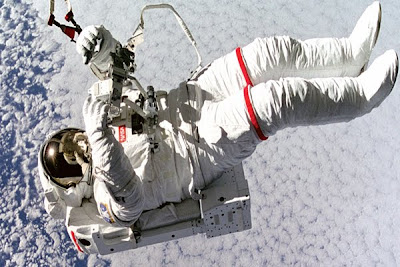
For the first time in nearly 50 years of American human spaceflight, Kennedy Space Center could be at the forefront of designing, developing, demonstrating and flying human-rated vehicles. "We're looking to create a robust commercial space program with multiple customers, multiple providers and multiple systems that take Americans to the International Space Station and other low Earth orbit destinations," said Ed Mango, director of the Space Transportation Planning Office. In May, the office sent out a Commercial Crew Initiative Request for Information (RFI). Mango, along with the office's Exploration Systems Mission Directorate (ESMD) Planning Lead Phil McAlister, Deputy Program Planning Manager Brent Jett and Insight Manager Scott Thurston, recently participated in a forum at NASA Headquarters to talk about common themes captured from dozens of industry responses.
ESMD Deputy Administrator Dr. Laurie Leshin, Commercial Orbital Transportation Services (COTS) Program Manager Alan Lindenmoyer and the Space Transportation Office's Deputy Director Maria Collura also were on hand to offer insight. "We have about 50 team members from shuttle, space station, Constellation, the Launch Services Program, the astronaut office, other NASA centers and contractors all coming together and melding our ideas of what commercial crew should be," Mango said. "And we're melding. it's like making gumbo and we just started making the roux." If the Commercial Crew Program is approved by Congress and the White House, it would have several billion dollars within a five- year period to develop humanrating requirements, partner with commercial entities and complete design and development. The program also would include demonstration flights.
"We believe that we could fund up to four providers with that $5.8 billion," McAlister said. "We definitely want competition. That is a key aspect to our strategy. We need multiple providers that are coming forward with innovative solutions." In addition to competition, will be collaboration. Thurston described more in depth about how NASA will take on a more "insight" role than its traditional "oversight" role and it's a change that the team doesn't take lightly. "NASA has to re-examine what has been our traditional identity," said Leshin, "and think about our role in a new way as catalysts of a much broader and more inclusive activity." Another aspect of collaboration would come from industries that are interested in performing science and research in low Earth orbit, whether on board the International Space Station or other future orbiting complexes.
ESMD Deputy Administrator Dr. Laurie Leshin, Commercial Orbital Transportation Services (COTS) Program Manager Alan Lindenmoyer and the Space Transportation Office's Deputy Director Maria Collura also were on hand to offer insight. "We have about 50 team members from shuttle, space station, Constellation, the Launch Services Program, the astronaut office, other NASA centers and contractors all coming together and melding our ideas of what commercial crew should be," Mango said. "And we're melding. it's like making gumbo and we just started making the roux." If the Commercial Crew Program is approved by Congress and the White House, it would have several billion dollars within a five- year period to develop humanrating requirements, partner with commercial entities and complete design and development. The program also would include demonstration flights.
"We believe that we could fund up to four providers with that $5.8 billion," McAlister said. "We definitely want competition. That is a key aspect to our strategy. We need multiple providers that are coming forward with innovative solutions." In addition to competition, will be collaboration. Thurston described more in depth about how NASA will take on a more "insight" role than its traditional "oversight" role and it's a change that the team doesn't take lightly. "NASA has to re-examine what has been our traditional identity," said Leshin, "and think about our role in a new way as catalysts of a much broader and more inclusive activity." Another aspect of collaboration would come from industries that are interested in performing science and research in low Earth orbit, whether on board the International Space Station or other future orbiting complexes.
No comments:
Post a Comment